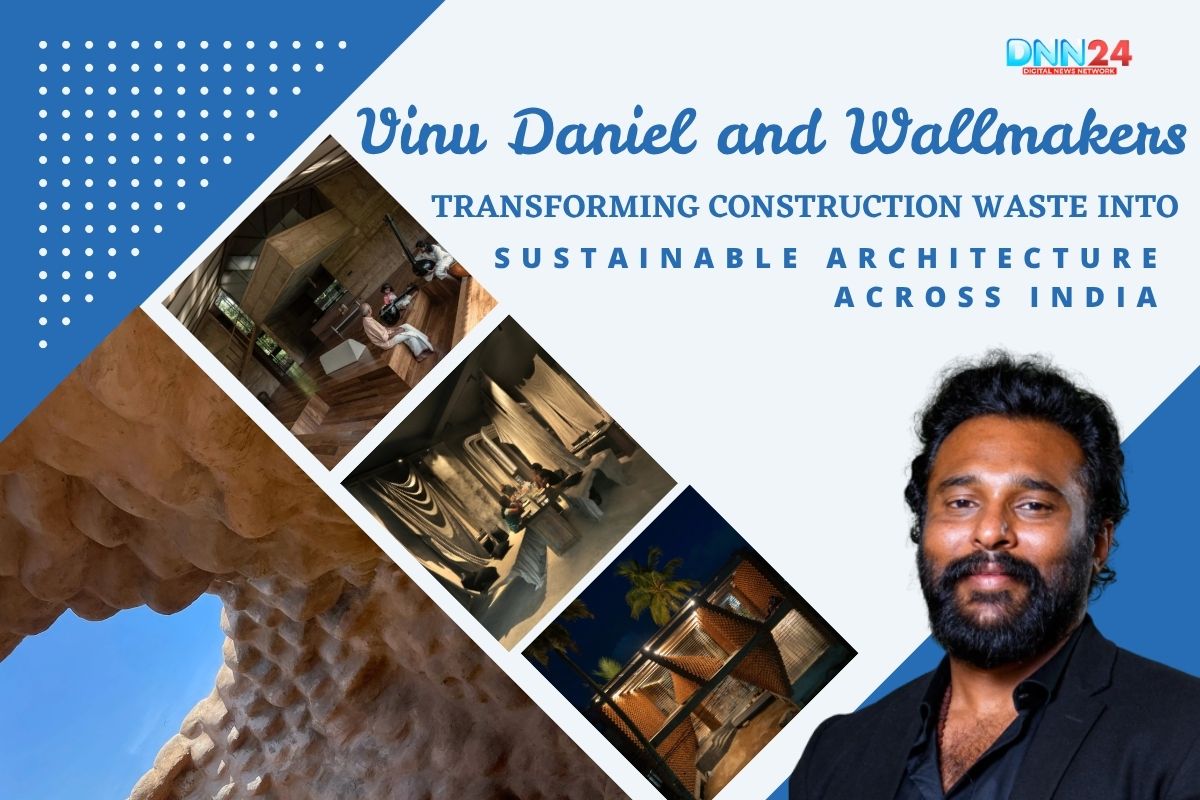In Kerala, one architect decided that broken bricks, discarded bottles, and construction debris deserved a second chance. His name is Vinu Daniel, and his practice Wallmakers is changing how India builds.
Vinu Daniel completed his architecture degree at The College of Engineering, Trivandrum, in 2005. Most of his batchmates rushed toward big firms and comfortable salaries. Vinu took a different road. He joined the Auroville Earth Institute and worked with UNDP on post-tsunami reconstruction projects. Standing among damaged homes and displaced families taught him what classrooms could not. Architecture was not about impressive drawings or personal glory. It was about providing shelter to those who had nothing left. He saw broken families finding hope again inside simple structures. Those experiences altered his understanding of buildings. They were not monuments but spaces that could heal wounds and restore dignity during terrible times. The suffering he witnessed became his most excellent teacher.
When Vinu returned to Kerala in 2007, someone approached him with a basic request. They needed a simple, yet sturdy, compound wall. That ordinary project became the starting point of everything. He named his practice Wallmakers after that first boundary wall. The name showed his humble beginnings. While building it, something extraordinary happened. Neighbours wandered over and started helping. Children picked up stones and carried them around.
Workers shared stories from their villages while preparing mortar. That wall used whatever materials were available nearby. It looked rough in places, but stood firm. Watching strangers become a team taught Vinu a valuable lesson. Good architecture listens to its surroundings, uses what nature provides, and brings people together. That simple compound wall planted the seeds of a revolution.
Wallmakers: Struggling Against Disbelief and Traditional Thinking
Starting something new always brings difficulties. Vinu faced them constantly. Experienced architects dismissed his methods as impractical. Potential clients worried that walls made from broken bricks would collapse. Money was always tight. Vinu has mentioned times when his entire office consisted of just three pencils and tremendous determination. Friends expressed concern about his career choices. Conventional builders mocked the idea of using construction debris. Why bother with waste when fresh cement and new bricks were readily available? Their words hurt, but Vinu kept thinking about bigger problems. The planet was suffering from climate change and disappearing resources. Should architects continue to build in the same destructive way? He decided to question everything he had learned.
Instead of ordering brand new materials, he started collecting what others discarded. Broken tiles, empty bottles, and demolished building parts became treasures. Projects like Nisarga Art Hub in Angamaly and St. George Orthodox Church in Mattancherry demonstrated that his techniques were actually effective. Still, many people refused to believe. One client left halfway through a project, convinced debris walls were dangerous. Vinu did not waste time arguing.
He constructed test walls behind his house. Village people came to examine them, tapping with sticks, amazed at their strength. Every failure taught him something. Every obstacle made his ideas clearer. Gradually, trust began building. What looked crazy became normal. Wallmakers stopped being just a construction company. It became a movement challenging wasteful practices across the industry. Vinu showed that real innovation requires standing firm even when everyone doubts you.
Wallmakers:Transforming Trash Into Architectural Treasures
Where most people see rubbish, Vinu Daniel discovers opportunities. His famous techniques, the Debris Wall and Shuttered Debris Wall, grew from this different way of seeing. Visit a Wallmaker’s site and you will not find fancy equipment or expensive imported materials. Instead, you see blueprints for protecting the environment. Bottles heading toward garbage dumps become beautiful design features. Broken bricks arrange themselves into artistic patterns. Vinu frequently says that building with waste means building hope for tomorrow. His team recalls long evenings spent testing new ideas. Their laughter mixed with the sounds of glass pieces clicking together. Afternoon tea breaks turned into creative discussions. Every recycled material carries its own history before being incorporated into a new structure.
The Wallmakers’ method begins by carefully observing what already exists at any location. Ancient stones discovered behind old temples find new purpose in verandahs. Debris from torn-down buildings serves as the foundation for new construction. This approach goes beyond saving money. It turns environmental damage into practical solutions. The process carries deep significance as well. Each wall represents strength rising from failure.
Beauty emerges from things society rejected. Hope takes solid, touchable form. Students, residents, and other architects observe and absorb these lessons. They begin questioning what everyone accepts without a second thought. Why transport materials from distant places when local waste works perfectly? Projects like Chuzhi house in Shoolagiri demonstrate this thinking beautifully. During one community gathering, Vinu shared a thought that captures his essence. The earth never fails those who build with honest care. That straightforward wisdom directs everything Wallmakers produces. Construction becomes a caring profession, not merely a commercial activity.
Small Stories That Reveal True Character
Beyond prizes and fame lie smaller moments that reveal the true spirit of Wallmakers. During the construction of the 3-Minute Pavilion in Sharjah, refugee children watched through fences, fascinated by the unusual walls. Rather than chasing them away, Vinu welcomed them inside. He showed them how to mix earth with water properly. Their parents joined later, learning skills they would use afterwards to build their own temporary homes. These incidents rarely appear in magazine features, but they define what Wallmakers truly represents. Architecture that welcomes everyone, shares knowledge freely, and serves real communities with respect.
Another remarkable story involves Tease Me Cafe in Kottayam. The location was literally a garbage dump. Everyone said nothing worthwhile could emerge there. Vinu did not simply draw plans and leave. He lived on that site during the entire construction period. He shared meals with labourers, sketched designs while sitting on piles of debris, and slept in makeshift shelters. People witnessed his complete commitment. Those who doubted became supporters.
The cafe changed from wasteland into a cheerful meeting place. A similar dedication shaped the Kochi-Muziris Biennale Pavilion in 2014 and the Toy Storey project in Calicut. Thrown-away objects became charming, meaningful spaces. Every project delivered the same truth. Architecture must serve place and people, not just drawings and profits. Through permit struggles, public arguments, moments of uncertainty, and impressive victories, Vinu remained grounded. His work demonstrates that buildings created with genuine feeling, connected to the earth, and built on trust in ordinary people will always endure.
Also Read: Deep Narayan Nayak: Teacher of the Street Who Turned Walls into Blackboards
You can connect with DNN24 on Facebook, Twitter, and Instagram and subscribe to our YouTube channel.

